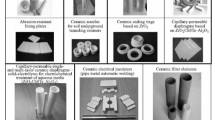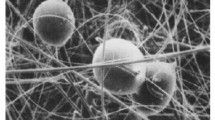Conclusion
The concept of developing new materials with prescribed properties based on ideas about "building" structures may be realized in creating ceramic composite materials. Creation of heterogeneous composite structures is the main path for achieving high crack resistance (a parameter which mainly governs the operating reliability of structural articles). These structures make it possible to realize energy-consuming processes of the dissipation of work for failure from external forces. The level of properties achieved (crack resistance above 300 N/mm3/2, strength above 500 N/mm2), and the high permissible operating temperatures make ceramic composite materials irreplaceable for a number of fields of technology. However, the main problems connected with the development of ceramic composites remain unresolved. These are problems for achieving the optimum structure and composition of the interface for components, thermal stability of reinforcing elements, the production cost of both fibers and composite materials, and obtaining highly compact matrices in composite materials reinforced with continuous fibers.
Similar content being viewed by others
Literature cited
K. Okamura, "Ceramic fibers from polymer precursors," Composites,18, No. 2, 107–120 (1987).
J. H. Adair, B. C. Mutsuddy, and E. J. Drauglis, "Stabilization of silicon carbide whisker suspension," Adv. Ceram. Mater.,24, No. 3, 231–234 (1988).
C. M. Barinov and P. I. Andriashvili, "Precritical crack propagation in brittle materials with uniform loading," Fiz.-Khim. Mekh. Mater., No. 6, 21–24 (1988).
G. P. Cherepanov, Mechanics of Brittle Fracture [in Russian], Nauka, Moscow (1974).
P. F. Becher, C. N. Hsueh, P. Angelini, and T. N. Tiegs, "Theoretical and experimental analysis of the toughening behavior of whisker reinforcement in ceramic materials," Mater. Sci. Eng.,107, No. 6, 257–259 (1989).
M. Gomina, J. L. Chermant, and F. Osterstock, "Applicability of fracture mechanics to fiber reinforced CVD ceramic composites," in: Fracture Mechanics of Ceramics, Plenum, New York,7, No. 7, 17–32 (1987).
Additional information
Scientific Production Association of the Institute of Aviation Materials. Interbranch Scientific Research Center of Technical Ceramics. Translated from Metallovedenie i Termicheskaya Obrabotka Metallov, No. 2, pp. 36–40, February, 1992.
Rights and permissions
About this article
Cite this article
Fridlyander, I.N., Shevchenko, V.Y. & Barinov, S.M. Ceramic composite materials. Met Sci Heat Treat 34, 133–138 (1992). https://doi.org/10.1007/BF00769881
Issue Date:
DOI: https://doi.org/10.1007/BF00769881




